新编外贸英语口语教程lesson 10 Post and Telecommunications Service
- 格式:ppt
- 大小:835.00 KB
- 文档页数:3
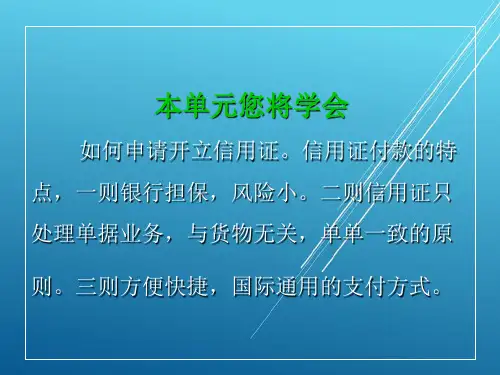
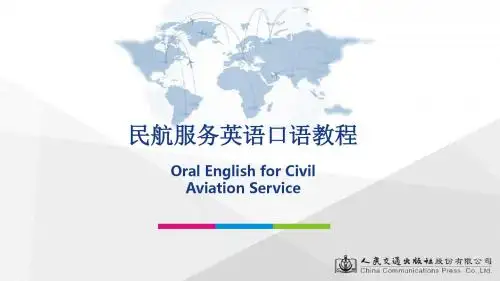

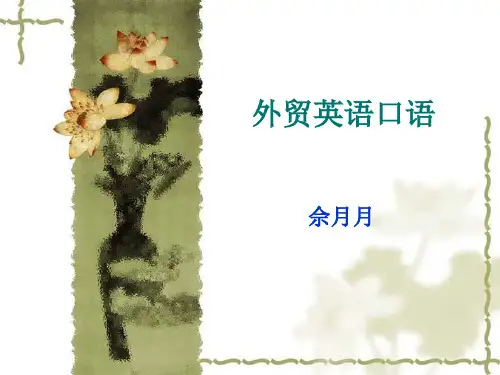
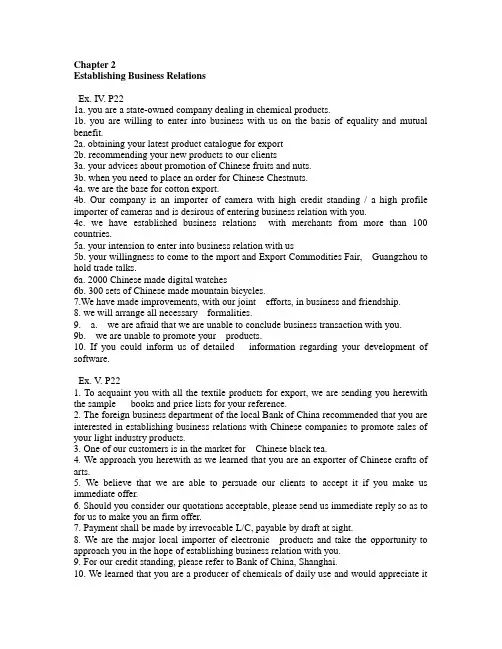
Chapter 2Establishing Business RelationsEx. IV. P221a. you are a state-owned company dealing in chemical products.1b. you are willing to enter into business with us on the basis of equality and mutual benefit.2a. obtaining your latest product catalogue for export2b. recommending your new products to our clients3a. your advices about promotion of Chinese fruits and nuts.3b. when you need to place an order for Chinese Chestnuts.4a. we are the base for cotton export.4b. Our company is an importer of camera with high credit standing / a high profile importer of cameras and is desirous of entering business relation with you.4c. we have established business relations with merchants from more than 100 countries.5a. your intension to enter into business relation with us5b. your willingness to come to the mport and Export Commodities Fair, Guangzhou to hold trade talks.6a. 2000 Chinese made digital watches6b. 300 sets of Chinese made mountain bicycles.7.We have made improvements, with our joint efforts, in business and friendship.8. we will arrange all necessary formalities.9. a. we are afraid that we are unable to conclude business transaction with you.9b. we are unable to promote your products.10. If you could inform us of detailed information regarding your development of software.Ex. V. P221. To acquaint you with all the textile products for export, we are sending you herewith the sample books and price lists for your reference.2. The foreign business department of the local Bank of China recommended that you are interested in establishing business relations with Chinese companies to promote sales of your light industry products.3. One of our customers is in the market for Chinese black tea.4. We approach you herewith as we learned that you are an exporter of Chinese crafts of arts.5. We believe that we are able to persuade our clients to accept it if you make us immediate offer.6. Should you consider our quotations acceptable, please send us immediate reply so as to for us to make you an firm offer.7. Payment shall be made by irrevocable L/C, payable by draft at sight.8. We are the major local importer of electronic products and take the opportunity to approach you in the hope of establishing business relation with you.9. For our credit standing, please refer to Bank of China, Shanghai.10. We learned that you are a producer of chemicals of daily use and would appreciate itvery much if you could send us samples by airmail as one of our clients are interested in purchasing cosmetics from your country.Chapter 3 Enquiries and OffersExercise1. Please quote us your price for 200 metric ton of steel sheets CFR Qingdao, stating the specifications.2.Our price of/quotation for fountain pens is RMB¥30 per dozen FAS.3. As regards payment terms, we require irrevocable L/C payable by draft at sight.4. Please find enclosed a copy of catalogue with pictures.5. We are likely to place a large order with you.6. Should your prices be competitive and delivery date acceptable, we would place an order with you.7. The buyer requires the seller to ship 10,000 metric ton of phosphate within a week’s time.8. We are sending you herewith our quotation list as per your enquiry No. 15 and looking forward to your confirmation.9. Please quote us your best/lowest/most favourable price CIF Shanghai, inclusive of our 3% commission10. We appreciate your enquiry of 16 March and make you our offer as follows:4,000 dozens of working gloves atRMB¥40 per dozen CIF Singapore for shipment during August/September.Payment shall be made by irrevocableL/C payable by draft at sight.The above offer is subject to our final confirmation.Chapter 4Making Counter-offers and Declining OrdersX. Exercise P471. We are closely studying your offer and hope that you can keep it open until the end of this month.2. We will grant you 10% discount if you can place an order for 3,000 dozen or more.3. As per your request / In compliance with your request / As requested, we make you firm offer for 50 metric ton of soy beans as follows, subject to the receipt of your reply by us within a week.4. Much to our regret, we are unable to take your offer owing to the substantial rise in prices of raw materials.5. Should your first parcels satisfy our clients, we believe you can secure more orders from them.6. We believe that it is easy for you to sell our woman’s dresses, as they have already enjoy fast sales in your market.7. For your reference, the price of groundnuts has been adjusted to RMB¥3,000 per M/T CIF London.8. As per your letter of March 10, we are offering you 1,000 sets of Shinco DVD as follows.9. To step up specific business transactions, we take the pleasure of offering you firm 2,500 sets of Hisense computers as follows, subject to our final confirmation.10. Your products will be competitive enough if you could lower/reduce your price by 2%.Letter CompositionYou got an inquiry for your colour TV sets from an importer in the USA. Please write a letter of offer, making your own assumptions.Letter CompositionDear Sir or Madam:Thank you for your inquiry of May 25, 2007.As requested, we make you firm offer forour colour TV sets as follows:Commodity: colour TV setsQuantity: 100,000 setsUnit Price: HK$8,000 per carton CIF QingdaoPayment: by confirmed, irrevocable L/C at sightLetter CompositionDelivery: during September/OctoberInsurance: to be covered by the buyer for 110%of invoice value against WPA.The above offer is subject to our final confirmation.As the market is strengthening and there is aheavy demand for our products, we suggest thatyou send us your reply as soon as possible.Yours sincerely,Chapter 5Conclusion of BusinessX. Exercises P621. We confirm herewith placing an order with you for 5,000M/Ts ore as per your quotation and terms of April 30, to be delivered before July 30.2. We take the pleasure in offering you walnuts, first grade, for shipment during October/November.3. We are carefully studying your terms, some of which are not acceptable for the time being. However, we will continue to work on them and inform you of our opinion some time later.4. We hope that you can try your best to bridge the price gap.5. We have established, with Bank of China, the L/C in your favour, amounting to Stg. £50,000.6. We are unable to meet your demand at present as your order is too large. However, wewill try our best to secure new supplies and inform you once the position improves.7. In view of our long and friendly relation, we will accept D/P at 60 days as an exception.8. Upon your acceptance of our draft at 30 days sight for US$58,000, the Milan Bank will hand over to you the shipping documents.9. Enclosed please find our Sales Contract No. 189 in duplicate. If there is no error, please countersign and return one copy for our file.10. With our repeated effort in negotiation, the manufacturer undertake to take fresh your order, supplying 100 sets per month since next January.X. Exercises P62Dear Sir or Madam:We have received your counter-offer of Sept. 10 for potato chips and confirm (the acceptance of ) accepting the offer as follows: 500 M/T potato chips at US$240 per M/T CFR Liverpool, inclusive of 5% commission. The quality of the goods is in conformity with that of sample Sp-03, with max. moisture content of 16% for shipment during November /December, 2004.•When opening the relevant L/C, please note that the parcel is bulk goods, with an allowance of 5% in quantity and amount. We hope that we can receive your confirmed, irrevocable L/C one month before the date of delivery so as to effect shipment in due course. As regards insurance, we will, as a rule, take out cover for 110% of invoice value against All risks and War risk as per the insurance clauses of PICC of China.Chapter 6 PaymentIX. Exercise P761. Please see to it that the payment is made by confirmed, irrevocable L/C payable at sight, allowing partial shipment and transshipment.2. We have considered your requirement of payment by D/P. In view of the small amount of the transaction, we are ready to arrange shipment accordingly.3. As per your request, we will make an exception to our customary practice, accepting L/C at 30 days. But it will in no case set a precedent.4. We will very much appreciate it if you can extend us accommodation.5. We have pleasure in informing you that the goods under the above contract have been ready for shipment. Please remit the full amount by T/T.6. We have drawn on you at sight for the value of this transaction.7. We have made it clear to you that your L/C must reach us by the end of the month so that we can ship the goods per S.S. “Dongfeng”, sailing for your port on the 15th of next month.8. Considering many year’s pleasant business relation between us, we agree to make concession and believe this will meet your demand.9. We believe that the accommodation will enable you to secure more orders for us.10. We regret that we are unable to accept D/P upon arrival of goods at the destination port.Chapter 7Establishment of and Amendment to L/CVIII. Exercise P881. Please note that 10,000 sets of sewing machine under Contract No. 535 have been ready for shipment for long, but we have not received the relevant L/C till now. Please expedite its establishment so that we can effect shipment.2. We herewith notify you that the irrevocable and confirmed L/C in your favour has been opened with Bank of China.3. We shall appreciate it if you effect amendment and advice us immediately.4. Please see to it that the L/C stipulations are in exact accordance with the terms of the contract.5. There is not enough time for our settlement of payment as the delivery and the validity are of the same date on your L/C. Therefore, please extend the validity date for 15 days as usual.6.We have received your L/C No. 568, but upon perusal, we find that transshipment andpartial shipment are not allowed. Please amend your L/C immediately.7. We will draw on you for this amount at sight through HSBC Bank, Hong Kong.8. We shall be willing to allow you an extension of 60 days upon your request, and sincerely hope that it w ill help you out of your present dilemma.9.To our regret, this credit was not properly amended despite our request.10. We have fax you today, asking you to make following amendments to L/C No. 256: “Shipped at Qingdao” instead of “Shipped at Shanghai”; “Metric Ton” instead of “Long Ton”.Chapter 8 ShipmentVI. Exercise P1011.We will continue to place orders with you as long as you can guarantee the quality ofgoods and make prompt shipment.Chapter 8 ShipmentVI. Exercise P1012. We wish to inform you herewith that the goods under Sales Contract No. 678 were shipped per S.S. “Nanhai” on July 5. T hey are to be transshipped via Hamburg and due to arrive at your port in early September3. We will hand over a set of clean, shipped on board bill of lading, made out to order, in triplicate to Commercial Bank of Midland, which will forward them to you.4. Our women’s tops are packed in plastic bags of on top each, 10 dozen to a carton, lined with waterproof paper, reinforced with 2 metal straps.5.With reference to our Order No. 689 for 1000 Calculators, we wish to advise you thatthe time for shipment has long been overdue.6. Please make it clear if your quotation covers the packing cost of wooden cases.7. As contracted, the above goods shall be delivered in three equal lots in April, Julyand August respectively. However, the first batch has not been delivered up until now. 8. There is not enough shipping space for 20,000 M/T of soy bean. Therefore, it is impossible to ship the goods in October. Please amend L/C to allow partial shipment.9. The goods shipped to our port must be transshipped via Hamburg. Therefore, your packing shall be seaworthy and can withstand rough handling during the transit.10. We regret to say that we are unable to deliver your order in advance due to present sources of supply.Chapter 9 InsuranceXII. Exercise II P 1151. We have the pleasure in informing you that the shipment of 10,000 tons Chemical Fertilizer under Contract No. 564 will be effected per S.S. “Qingshan” scheduled to leave here on 25th of May. Please arrange insurance for this cargo.2. Please see to it that the goods shall be covered for 120% of invoice value against All Risk and War Risk.3. We understand that you, as a rule, insure the goods only for 10% aboveinvoice value; therefore, the extra premium will be for our account.4. In the absence of definite instructions from our clients, we generally cover insurance against WPA and War Risk; if you desire to cover FPA, please let us know in advance.5. The rate charged against Breakage is 2%. We can arrange insurance against this risk on your behalf. The extra premium will be for your account.6. The goods are to be insured against leakage.7. We shall cover TPND on your order.8. This class of goods is sold with a franchise of 4%..9. The clause “All expenses are for the beneficiaries’ account” sho uld be deleted from the L/C.10. Please take necessary precautions that the packing can protect the goods from dampness or rain, since cement is liable to be spoiled by damp or water in transit. Chapter 10Complaints and ClaimsIX. Exercise p1271. Claim, if any, must be made (filed, put in) within 30 days after the arrival of the goods at the destination, otherwise, none will be considered.2. Disputes may be submitted for arbitration in case no agreement is reached through negotiation between the two parties.3. We may compromise, but the compensation should, in no case, exceed $800, otherwise this case will be submitted for arbitration.4. As evidenced by the survey report, damage to the cases and goods is due to rough handling during the transit, rather than poor packing as you believed.5. No trace of poor quality or poor craftsmanship has been found upon our inspection. The material used is of best quality.6. We consider that the suppliers are responsible for the short weight, as the surveyreport by Qingdao Commodity Inspection and Quarantine Bureau evidenced there is a short weight of 1000 kilo.7.We regret we cannot entertain your claim.8.It would not be fair if the loss be totally imposed on us, as the liability rests with bothparties. We are ready to meet you half way, say, to pay 50% of the loss only.9. We regret to inform you that the goods forwarded to us are no in conformity with the sample.10. On going into the matter we find a mistake was indeed made in the packing through a confusion of numbers, and we have arranged for the right goods to be dispatched to you at once.。

Breakfast in the kitchenIt’s time for breakfast. Richard comes into the kitchen to see if the breakfast is ready. Richard: Good morning, Mom.Mrs. White: Morning. What do you want to have for breakfast?Richard: I’ll have two fried eggs, toast and a cup of coffee, please.Mrs. White: The coffee is brewing. Have some toast first. I’ll fry the eggs for you.Richard: Thank you. Is Dad up?Mrs. White: He is shaving and washing his face. No, I hear him coming.Mr. White: Good morning.Mrs. White: Good morning. You’re going to have milk, aren’t you?Mr. White: Yes. I always have milk in the morning.Mrs. White: What else are you going to have?Mr. White: Just an English muffin. I had one yesterday, it was delicious.Mrs. White: Do you want some fried eggs?Mr. White: I’d rather have sausage this morning.Mrs. White: Richard, here are the fried eggs for you. Coffee is ready, you may pour a cup yourself, and one cup for me if you don’t mind. I’ll fry the sausage for your father. Richard: OK.Mr. White: The fried eggs look good. Let me try a little.Richard: There’re two. You can take one.Mr. White: Thank you. Sophia, I’ll have some eggs. You don’t need to fry the sausage.Mrs. White: I t’s nearly ready. I’ll have the sausage myself then. By the way, are you going to have supper at home?Richard: I’ll go to my old classmate’s home to join in his birthday party with my girlfriend tonight.Mr. White: I’ll be home for supper.Mrs. White: Shall we have beef steak for supper?Mr. White: Beef steak again? We had it yesterday and the day before yesterday. How about fish? A cod, a cod with pickled vegetables.Mrs. White: I like cod with pickled vegetables, too. But I don’t know how to cook it. Then how about having our dinner at the Park Hotel tonight?Mr. White: I couldn't agree more.Richard: Dining in the Park Hotel without me again? How disappointed I am, you know?Dinner in the Park HotelMr. Henry White and his wife are having dinner with Henry’s old classmate, Dan Jackson in the Park HotelHenry: 我们今天晚上来点中国酒吗?他们有茅台和一种叫“王朝(dynasty)”的酒。
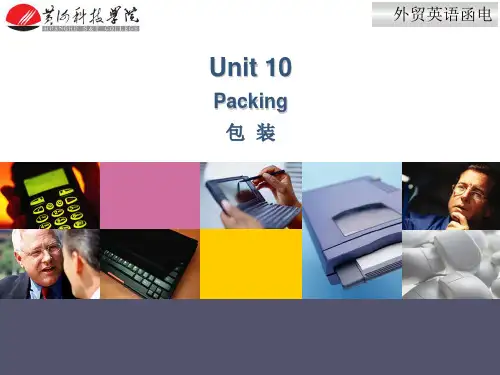
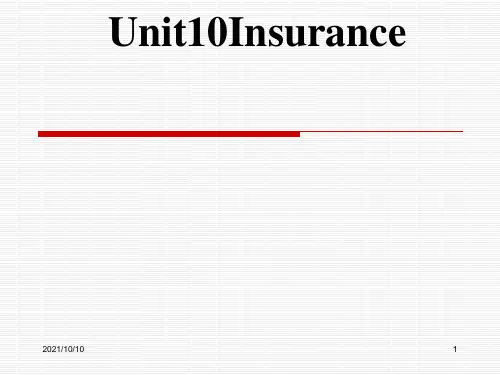
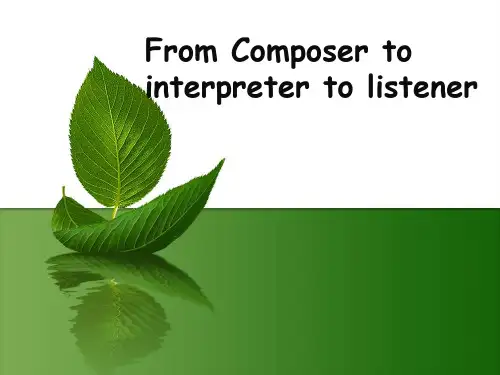


【外贸英语口语】外贸英语之给国外客户的通知书信(中英双语)【外贸英语口语】外贸英语之给国外客户的通知书信(中英双语)外贸业务员与外商联系时,商务信函有的时候不仅仅只是询盘、还盘,当公司发生重大事件时,外贸业务员可能需要给你的外国客户写一封通知书以告知对方。
外贸中的通知书书写范例如下,供大家参考。
开业通知为了方便居住本地之顾客, 我方特在本地区开设分店, 以便供应品质可靠、款式新颖、价格公道的服装。
恳请惠顾。
We have opened a new branch in this district, for the convenience of our customers who live here, and for residents who wish to obtain clothing of the newest style and most reliable quantity at reasonable prices.兹定于本月一日我们在本市以约翰.史密斯的名义开设绸缎棉布行, 特此奉告。
We inform you that on the 1st of this month, we established in this city a Dry-Goods business under the firm-name of John & Smith.我们将以钱伯斯公司为名, 开设总代销店, 特此奉告。
We acquaint you that we have established ourselves as general agents under the title of Chambers & Co.我非常荣幸地通知您, 我已在本市开了一家日本货批发代销店。
I have the honour to inform you that I have just established myself in this town as a Commission Merchant for Japanese goods.我十分高兴地通知您, 在当地几家有名望, 有影响力公司的支持下, 我开设了轮船与保险的经纪业以及总代理店。
Lesson10 International Payment Generally speaking, it is not very difficult for buyers and sellers in domestic trade to get to know each other’s financial status and other information, and payment is likely to be made in a straightforward manner, say (for example)by remittance or by debiting the debtor’s account. In international trade, however, things are far more complicated. Purchase and sale of goods and services are carried out beyond national boundaries, which make it ratherdifficult for the parties concerned in the transaction to get adequate information about each other’s financial standing and creditworthiness (资信;信誉). Therefore, mutual trust is hard to build. Both the exporter and importer face risks as there is always the possibility that the other party may not fulfill the contract.For the exporter there is the risk of buyer default(不按期付款). The importer might fail to pay in full for the goods. He might go bankrupt.His government might, for various reasons, ban(禁止)trade with the exporting country or ban imports of certain commodities. The buyer might run into difficulties getting the foreign exchange to pay for the goods. It is even possible that the buyer is not reliable and simply refuses to pay the agreed amount on various excuses.On the part of the importer, there is the risk that the shipment will be delayed, and he might only receive them long after payment.The delay may be caused by problems in production or transportation, and such delays may lead to loss of business. There is also a risk that wrong goods might be sent as a result of negligence(疏忽大意)of the exporter or simply because of his lack of integrity (honesty).Political risks such as war, quotas, foreign exchange control; commercial risks like market change and exchange rate fluctuations(波动); and even language barriers all add upto (increase)the problems in international trade. Because of these problems and risks, exporters are hesitant to release their goods before receiving payment, while importers prefer to have control over the goods before parting with their money.Various methods of payment have been developed to cope with different situations in international trade. When the political and economic situation in the importing country makes payment uncertain or when the buyer’s credit standing isdubious (doubtful), the exporter may prefer cash in advance or partial cash in advance. In this case, the importer has no guarantee that the exporter will fulfill his obligations once he has made payment by cash. If the buyer and the seller know each other well, they may decide to trade on open account. This means that no documents are involved and that legally (in terms of law) the buyer can pay anytime. The seller loses all control over the goods once they have been shipped. Sales on thisbasis are usually paid for by periodic payment, and obviously the exporter must have sufficient financial strength经济实力to carry the cost of the goods until receiving payment. If the exporter wishes to retain(保留)title or ownership(所有权)to the goods, he can enter into consignment transactions. This means the exporter has to send his goods abroad and will not get payment until the goods are sold. If not sold, the goods can be shipped back. Therefore, this arrangementshould only be made with full understanding of the risks involved and is preferably to be limited to stable countries where the exporter has a trusted agent to look after his interest.A lot of international transactions are paid for by means of the draft(汇票), which, also referred to as the bill of exchange, is an unconditional(无条件的)order to a bank or a customer to pay a sum of money to someone on demand(立即)or at a fixed time in the future.The person who draws(开立)the draft, usually the exporter, is called the drawer(出票人), and the person to whom the draft is drawn is called the drawee(受票人). There is yet another party payee(收款人), i.e. the person receiving the payment, who and the drawer are generally but not necessarily the same person, as the drawer can instruct the drawee either to pay “to the order of ourselves” or to the order of someone else, for instance, the bank.A draft is either a sight draft ora usance draft (also called tenor draft or term draft). The former calls for (needs)immediate payment on presentation (提示) to the drawee while the latter is payable at a later date, e.g. 30, 45, 60, or 90 days after sight or date. A draft is either clean (clean draft 光票) (without documents) or documentary (documentary draft跟单汇票). In the latter case, the draft is accompanied (attached)by the relevant documents such as the bill of lading, the invoice, the insurance policy etc.In documentary collection ( 跟单托收), the exporter sends the draft and the shipping documents运输单据representing title to the goods to his bank, which forwards (sends) them to anot her bank in the importer’s country, which in turn contacts the customer (importer). In the case of documents against payment (D/P)付款交单, documents will not be released to the importer until payment is effected执行. There are D/P at sight and D/P after sight. The former requires immediate paymentby the importer to get hold of the documents. The latter gives the importer a certain period after presentation of the documents, but documents are not released to him until he actually pays for the merchandise货物. In the case of documents against acceptance (D/A)承兑交单, documents are handed over to the importer upon his acceptance(承兑)of the bill of exchange drawn by the exporter. Payment will not be made until a later date. D/A is always after sight.So far as the exporte r’s interest is concerned, D/P at sight is more favorable than D/P after sight, and D/P is more favorable than D/A. In actual trade, payment by collection should be accepted with discretion (小心). It is usually used when the financial standing of the importer is sound(良好的), or when the exporter wishes to push the sale of his goods, or when the transaction involves only a small quantity. Otherwise, the letter of credit is generally preferred.Lesson 11In international trade it is almost impossible to mach payment with physical delivery (实际交货) of the goods, which constitutes conflicting problems for trade, since the exporter prefers to get paid before releasing the goods and the importer prefers to gain control over the goods before paying the money. The letter of credit is an effective means to solve these problems. Its objectiveis to facilitate international payment by means of the credit-worthiness of the bank. This method of payment offers security to both the seller and the buyer. The former has the security to get paid provided (假如) he presents impeccable(没有缺陷的)documents while the latter has the security to get the goods required through the documents he stipulates in the credit. This bilateral security is the unique and characteristic feature of the letter of credit.“Letter of credit” is often shortenedas L/C or L.C. and is sometimes referred to as “banker’s commercial letter of credit”, “banker’s credit”, “commercial credit” or simply “credit”. Modern credits were introduced 开始采用in the second half of the 19th century and had substantial development after the First World War. The credit is a letter issued by a bank at the request of the importer in which the bank promises to pay upon presentation of the relevant documents. It is actually a conditional bank undertaking(承诺)of payment.The operation of the letter of credit starts with the importer. He instructs his bank to issue an L/C in favor of the seller (以…为收益人)for the amount of the purchase. Here the importer is called the applicant (开证申请人), or opener, principal etc., the bank that issues the credit is called the opening bank, the issuing bank or the establishing bank, (开证行) and the exporter in whose favor the credit is opened is called the beneficiary(受益人). The openingbank sends the credit to its correspondent bank(往来行)in the exporter’s country, who will, after examining(检查)the credit, advise (通知)the exporter of its receipt. Here the correspondent bank is called the advising bank(通知行). The exporter or beneficiary will make a careful examination(仔细检查)of all the contents of the credit and will request the opener to make amendments修改to any discrepancies (不一致)in the credit so as to ensure safe and timelypayment. Sometimes the exporter may require a confirmed letter of credit (保兑信用证) either because the credit amount is too large, or because he does not fully trust the opening bank. The bank that adds its confirmation(保兑)to the credit is called the confirming bank which is undertaken(承担)either by the advising bank or another prime (big)bank. When everything with the credit is in order, the exporter will prepare the relevant documents based on the credit and dispatch thegoods to the importer. Then he will present the draft and the accompanying documents to the advising bank that pays or accepts (承兑) or negotiates(议付)the bill of exchange. The advising bank then also becomes the paying bank which acts as the agent of the opening bank and gets reimbursed(pay back)by the opening bank after paying the beneficiary. If a bank, either nominated (指定)by the opening bank or at its own choice, buys the exporter’s draft submitted to it undera credit, it is called a negotiating bank (议付行). The draft and the documents will then be sent to the opening bank for reimbursement(偿付).Letters of credit are varied in form, length, language, and stipulations. Generally speaking, however, they include the following contents:1. The number of the credit and the place and time of its establishment.2. The type of the credit.3. The contract on which it is based.4. The major parties relevant to thecredit, such as the applicant, opening bank, beneficiary, advising bank. etc.5. The amount or value of the credit.6. The place and date on which the credit expires(失效).7. The description of the goods including name of commodity, quantity, specifications, packing, unit price, price terms, etc.8. Transportation clause(条款)including the port of shipment, the port of destination, the time of shipment, whether allowing partial shipments or transshipment(转船).9. Stipulations relating to the draft.10. Stipulations concerning the shipping documents required.11. Certain special clauses if any.e.g. restrictions on the carrying vessel(承运船只)and the route.12. Instructions to the negotiating bank.13. The seal or signature of the opening bank.14. Whether the credit follows “the uniform customs and practice for documentary credits”.The letter of credit providessecurity to both the exporter and the importer. However, it only assures payment to the beneficiary provided the terms and conditions of the credit are fulfilled. It does not guarantee that the goods purchased will be those invoiced or shipped. It is stipulated in Article 4 of the uniform customs and practice for documentary credit that “in credit operations all parties concerned deal in documents, and not in goods, services and/or other performance to which the documents may relate”.That is to say the banks are only concerned with the documents representing the goods instead of the underlying contracts. They have no legal obligation whether the goods comply with the contract. They will be considered as having fulfilled their responsibility so long as all the documents comply with the stipulations of the credit. The quality and quantity of merchandise shipped, although specified in the documents, ultimately depend on the seller who has manufactured, packaged, andarranged shipment for the goods.If the importer finds any problems with the goods, e.g. inferior quality or insufficient quantity, he has to contact or even take legal action against the exporter instead of the bank so long as the documents are “proper” on their face.Lesson 12Letters of credit fall under several categories depending on their function, form and mechanism. Here are the major types of credit:1. Clean credit and documentary credit: Credits that only require clean draft, i.e. draft not accompanied with shipping documents, for payment are clean credit. They are generally used in non-trade settlement(非贸易结算)or in payment in advance by means of the L/C. Most of the credits used in international trade are documentary credits, i.e. credits that require shipping documents to be presented together with the draft.2.Revocable credit andirrevocable credit: This classification is based on the certainty确信of the commitment 承诺to pay on the part of the applicant and the issuing bank. The credit is a revocable one if such commitments can be altered (改变)or even canceled(取消)without consulting with the beneficiary. It is quite obvious that the exporter has little assurance 保证to get payment, and therefore this type of credits are rarely used. Irrevocable credits are those that cannot be amended (revised修改)or revoked(取消)without the consent(同意)of all the parties concerned. Safe and reliable, this type is extensively(widely)used in world trade. It must be noted that if there is no specific indication whether a credit is revocable or irrevocable, it should be regarded as irrevocable.3. Confirmed credit and unconfirmed credit: If a credit is confirmed by a bank other than (除…之外)the issuing bank, it becomes a confirmed credit. The confirmation is undertaken 承担either by theadvising bank or by another leading bank. Under a confirmed credit, the beneficiary is given double assurance of payment 双重付款担保since the confirming bank has added its own undertaking 承诺to that 承担of the opening bank. If the credit is not confirmed by another bank, it is an unconfirmed letter of credit. Though a confirmed credit is considered to be able to provide the greatest degree of security to the beneficiary, it involves additional cost as a result of the confirmation.Therefore if the establishing bank is a reliable prime bank, confirmation may not be necessary.4. Sight credit and usance credit: A sight credit is one by which payment can be made upon presentation of the draft and impeccable documents by the beneficiary to the bank. It gives the beneficiary better security and helps him speed up his capital turnover. 资金周转Most of China’s export contracts stipulate for sight credit in payment terms. Obviously, a sight credit calls for a sight draft.It is also clear that this type of credit requires a usance draft. If the beneficiary wishes to get payment before the maturity到期of the draft, he can ask the bank to discount贴现the acceptance, and immediately pay him the net proceeds净收益(net position 实际头寸), i. e. the face value 面值of the draft minus减去the discount charges收费.5. Transferable credit andnon-transferable credit: If a credit can be transferred by the original beneficiary to one or more parties, it is a transferable credit. The original beneficiary is called the first beneficiary and the party (or parties) the credit is transferred to is called the second beneficiary. It is usually used when the first beneficiary is a middleman and does not supply the goods himself. A credit can be transferred only once. But transferring a credit to more than one party at the same time is allowedprovided partial shipments are permitted. If a credit does not specify whether it is transferable, it should be regarded as a non-transferable document according to the credit stipulation.6. Non-draft credit: There is a modern tendency for payment to be made by presentation of the documents without the formality of drawing and presenting a draft. Such credits are non-draft credit. They mainly include payment credit and deferred payment credit which arerespectively similar to sight credit and usance credit with the difference that no draft is drawn and presented in the case of non-draft credit.7. Revolving credit: If a credit stipulated that its amount can be renewed更新or reinstated恢复without specific amendment to the credit being made, it is then a revolving credit. It is particularly useful when the buyer and seller have regular trading relationship and deal in a specific quantity of goods each month or any particular periodof time.It has already been mentioned that the letter of credit has greatly facilitated便利and promoted international trade. However, like any other methods (mode) of payment, it is not perfect. It cannot provide absolute security for the contracting parties. The seller may sustain losses 蒙受because of the buyer’s delay even failure in the establishment of credit开立信用证. The buyer may suffer losses as a result of the documents presented bythe seller which do not truly represent the goods shipped. And it is not absolutely avoidable that the bank may become insolvent破产的or bankrupt. Besides, it is more expensive to use the letter of credit than remittance or collection as the bank will charge 收费its client for all the services it provides. So the letter of credit may not be the most ideal(best)method of payment for a particular transaction, and the contracting parties should make their best choice according to the specificconditions.Lesson 13One of the major differences between domestic trade and foreign trade is documentation (单据的使用). Every shipment must be accompanied by a number of correct documents. If they are not the correct ones, the importer will have difficulties in taking delivery of 提货the goods, and delays caused byincorrect documentation may affect future business relations between the trading partners. In the case of documentary letter of credit, any discrepancy不同, even in minor details, between the documents presented and those specified in the credit may lead to refusal by the bank to make payment. Different documents are required for different transactions, depending on the nature of the deal, the term of delivery, the type of commodity, stipulations of credit, regulations and practices indifferent countries, etc. However, most transactions require the following major documents.The commercial invoice:Generally called “the invoice” for short, this document is the general description of the quality and quantity of the goods and the unit and total price. It constitutes the basis on which other documents are to be prepared制作, and the banks check the conformity between credit terms and documents 单证一致and the conformity between thedocuments单单一致. A commercial invoice normally include the following contents: Invoice number and the date; name and address of the buyer and the seller; contract number and credit number; description of the goods including name of the commodity, quantity, specifications, etc.; unit price, total price, price terms, and commission and discount if any; terms of delivery and terms of payment; packing, shipping marks唛头, etc.; and seal or signature of the exporter.It should be noted that the description of the goods in the invoice must comply with the credit while in other documents the goods can be described in general terms, and that the total invoice value should not exceed the total amount of the covering(适用的)L/C.The packing list (is a document that)gives information such as the number, date, name and description of the goods, shipping marks, packing, number of packages, specific contents of each packageand its net weight and gross weight etc. Sometimes the credit stipulates for specification list规格清单which is similar to the packing list but emphasizes the description of the specifications of the goods. The weight list, weight note, or weight memo are also similar to the packing list in content and function but emphasis on the weight of the goods and are generally used for goods which are based on the weight for price calculation.The Bill of lading is one of themost important documents and has three major functions: 1. It serves as a cargo receipt signed by the carrier and issued to the shipper or consignor; 2. It constitutes a contract of carriage(transport)between the carrier and the consignor; 3. It is a document of title 所有权to the goods,and the legal holder 合法持有人of the bill of lading is the owner of the goods it covers.The major contents of the bill of lading include: 1. the carrier, i. e.the shipping company; 2. the shipper or consignor, it is normally the exporter; 3. the consignee收货人. It is generally either the importer or made out “to order”; 4. the notify party, i. e. the party to be advised通知after arrival of the goods at the port of destination. It is often the agent of the consignee or the consignee himself. 5. a general description of the goods including the name, number of packages, weight, measurement 尺寸etc. 6. shipping marks; 7. the port ofshipment and the port of destination;8. the freight运费, for CIF and CFRi t should be “freight prepaid”, or “freight paid”, for FOB it should be “freight to collect”, or “freight to be paid”, or “freight payable at destination”. 9. the place where the bill of lading is issued; 10. the date when the bill of lading is issued which is regarded as the time of shipment交货时间(time of delivery) and can by no means (never) be later than that stipulated in the credit.There are quite a few types of bills of lading classified in several ways. However, most letters of credit stipulate for “clean, on board bill oflading”. is one which states (indicate) that the goods have been shipped in apparent (表面上) good order and condition. It is meant that the document is devoid of 没有any qualifying remarks 批注性话语concerning the packing and the outer appearance of the goods. And the carrier admits full liability 承担全部责任for thegoods described in the bill of lading and is bound to 有责任carry the goods and deliver them in like (similar) condition in which he hasreceived them.indicates that the shipment has been actually loaded on the carrying vessel 承运船只bound for 开往the port of destination. Traditionally, this has been the only acceptable type to be presented by the seller under the term CFR and CIF.The document similar to theocean bill of lading 海运提单is called airway bill for air transportation and railway bill, cargo receipt etc. for railway transportation.The insurance policy and the insurance certificate are similar in function, the only difference being that the latter is a bit simpler than the former. The main contents of such insurance documents include: 1. the insured. Under CIF terms, the insured is generally the beneficiary of the credit unless otherwisespecified, while under CFR and FOB terms,the insured is usually the importer. 2. cargo description including name, quantity, weight, shipping marks etc . 3. the amount insured and the risks covered 险别. It should be noted that the currency of the amount insured should be the same as that of the credit. 4. contents concerning transportation including the carrying vessel, the port of shipment and the port of destination, the sailing date起航日期etc. 5. the place where claims are to be settled。